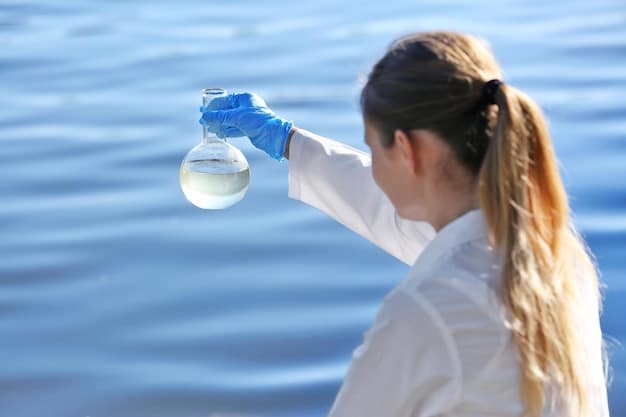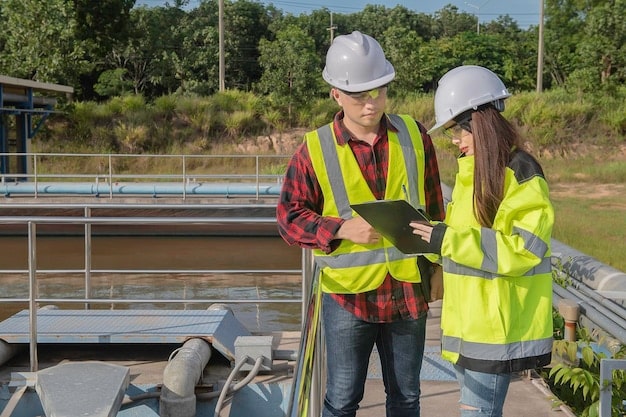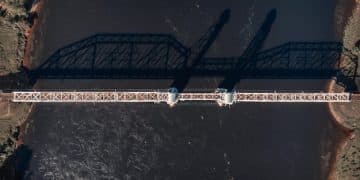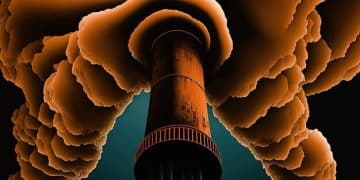Revised Clean Water Act 2025: US Industry Guide

The year 2025 marks a crucial turning point for US industries as the revised Clean Water Act regulations introduce significant changes, compelling businesses to adapt wastewater management practices to ensure compliance and avoid penalties as part of a broader commitment to environmental protection.
Understanding the Revised Clean Water Act Regulations: A Guide for US Industries in 2025 is imperative for businesses seeking to maintain compliance and mitigate environmental impact. These changes represent a significant evolution in federal oversight of water quality, affecting everything from discharge permits to storm water management. This guide aims to demystify the upcoming alterations, offering clarity and actionable insights for industry leaders.
Understanding the Foundation: The Clean Water Act (CWA)
The Clean Water Act, initially enacted in 1972, serves as the cornerstone of water quality protection in the United States. Its primary objective is to restore and maintain the chemical, physical, and biological integrity of the nation’s waters. For decades, it has dictated how industries manage their wastewater discharges, placing strict limits on pollutants and requiring permits for point source discharges.
Over the years, the CWA has adapted to evolving environmental challenges and scientific understanding. This iterative process of refinement ensures the Act remains relevant and effective in safeguarding one of our most vital natural resources. The upcoming revisions for 2025 are part of this ongoing commitment, reflecting new data, technological advancements, and a sharpened focus on emerging contaminants and ecosystem health.
Evolutionary Path of the CWA
The CWA has seen several key amendments since its inception. Early efforts focused heavily on controlling conventional pollutants from industrial and municipal sources. Subsequent amendments addressed issues like nonpoint source pollution, toxic pollutants, and wetlands protection. Each layer of revision has built upon the last, creating a comprehensive, albeit complex, regulatory framework.
Understanding this historical context is vital, as it highlights the continuous nature of environmental regulation. The 2025 revisions are not a sudden overhaul but rather a logical progression designed to enhance the Act’s efficacy in the face of contemporary environmental challenges. Industries must see these changes not as an isolated event, but as another step in a long journey of environmental stewardship.
- 1972: Initial enactment of the Federal Water Pollution Control Act, commonly known as the Clean Water Act.
- 1977: Amendments focused on toxic pollutants and emphasized best available technology economically achievable (BAT).
- 1987: Water Quality Act amendments addressed nonpoint source pollution and stormwater discharges.
- Ongoing: Continuous reviews and updates to address specific contaminants and emerging issues.
These revisions also reflect a deeper understanding of hydrological connectivity, recognizing that pollution in one area can quickly impact others. This holistic perspective drives many of the enhanced requirements, particularly concerning watershed protection and cumulative impacts. Industries are increasingly accountable for their contribution to broader environmental health, beyond just their immediate discharge points.
The core principles of the CWA remain steadfast: permit requirements for point source discharges, technology-based effluent limitations, and water quality standards. The 2025 revisions primarily aim to strengthen these existing pillars, close regulatory gaps, and address pollutants that were not adequately covered by previous iterations of the Act. Staying ahead of these changes is a proactive business strategy.
Key Revisions for 2025: What’s Changing?
The 2025 revisions to the Clean Water Act introduce several notable changes that industries across the United States must diligently prepare for. While the specifics are still being finalized and interpreted, broad strokes indicate a heightened emphasis on certain types of pollutants, expanded definitions of “Waters of the United States” (WOTUS), and more stringent compliance requirements. These adjustments aim to create a more robust water quality protection framework.
One of the most significant anticipated changes involves a clearer, potentially broader, interpretation of WOTUS, which determines the scope of federal jurisdiction under the CWA. Industries operating near wetlands, ephemeral streams, or other previously ambiguous water bodies may find themselves subject to new or intensified regulatory oversight. This expanded scope is designed to protect headwater systems and interconnected aquatic environments more effectively.
Expanded Scope of Regulated Waters (WOTUS)
The definition of WOTUS has been a contentious and fluctuating aspect of the CWA for decades. The 2025 revisions seek to provide a more stable and scientifically supported definition, likely leaning towards a broader inclusion of water bodies that significantly affect downstream navigable waters. This could bring many previously unregulated or ambiguously covered wetlands and small streams under federal protection, impacting a wide range of industrial activities.
For industries, this means a potential increase in the number of activities requiring CWA permits, such as those related to construction, infrastructure development, or any operation that might alter or discharge into these newly clarified waters. Understanding the precise geographical extent of these definitions will be crucial for land-use planning and project development. Proactive environmental assessments will become even more vital.
- Clarity: Aim for a more durable and clear definition following years of legal challenges.
- Connectivity: Emphasize the hydrological connections between smaller water bodies and larger navigable waters.
- Impact: Potentially expand federal jurisdiction to more wetlands, headwater streams, and isolated water features.
Another area of significant change is expected in the tightening of effluent limitations, particularly for emerging contaminants. Substances like Per- and Polyfluoroalkyl Substances (PFAS), microplastics, and certain pharmaceutical compounds are increasingly recognized as pervasive environmental threats. The 2025 revisions are likely to mandate more stringent treatment technologies and discharge limits for these persistent pollutants, requiring significant investment from affected industries.

Furthermore, there may be updated requirements for stormwater management and nonpoint source pollution, especially in urban and agricultural sectors. The revisions could introduce new best management practices (BMPs) or require more sophisticated monitoring systems to track and control runoff. This indicates a shift towards a more comprehensive approach to diffuse pollution, requiring industries to manage their land-based activities more carefully.
Finally, expect increased enforcement and reporting requirements. The EPA and state environmental agencies are likely to be empowered with more tools and resources to ensure compliance. This could translate to more frequent inspections, higher penalties for violations, and more detailed reporting obligations for permitted facilities. Transparency and robust data management will be key to avoiding enforcement actions.
Impact on Specific Industrial Sectors
The revised Clean Water Act regulations will not impact all industries equally. While broad in their application, certain sectors, by nature of their operations and discharge profiles, are likely to experience more significant changes and compliance burdens. Understanding these sector-specific implications is crucial for tailored preparation and strategic adaptation.
Manufacturing facilities, particularly those involved in chemical production, pharmaceuticals, and electronics, face heightened scrutiny due to their complex waste streams. The new emphasis on emerging contaminants such as PFAS and endocrine disruptors means these industries will likely require significant upgrades to their wastewater treatment systems. This could involve exploring advanced oxidation processes or specialized filtration technologies that were not previously mandatory.
Manufacturing and Chemical Industries
These sectors often have a diverse range of pollutants in their discharges, including heavy metals, volatile organic compounds, and, increasingly, synthetic chemicals. The 2025 CWA revisions are expected to introduce stricter effluent limitation guidelines (ELGs) for specific industrial categories, requiring the adoption of even more advanced pollution control technologies. This necessitates a comprehensive review of current processes and discharge characteristics.
- Pharmaceuticals: Greater scrutiny on active pharmaceutical ingredients (APIs) in wastewater.
- Electronics: Stricter limits on heavy metals and solvents used in manufacturing.
- Chemical Production: Enhanced requirements for the treatment of persistent organic pollutants.
The agricultural sector, historically a significant contributor to nonpoint source pollution from nutrient runoff and pesticides, may also see increased regulatory attention. While the CWA primarily addresses point sources, the broader WOTUS definition could indirectly lead to more pressure on agricultural operations that impact regulated wetlands or interconnected water bodies. Programs promoting best management practices (BMPs) for nutrient application and erosion control could become more widespread or even mandatory in certain regions.
The energy sector, encompassing power generation, oil and gas extraction, and renewable energy projects, faces unique challenges. New regulations might impact cooling water intake structures, thermal discharges, and produced water management in oil and gas operations. Furthermore, the development of renewable energy infrastructure, such as hydropower or large-scale solar farms potentially impacting wetlands, could come under closer CWA review due to the expanded WOTUS definition.
The construction and real estate development industries will be directly affected by any broadening of WOTUS. Projects involving extensive land disturbance, excavation, or work near water features may require more rigorous permitting processes, detailed environmental impact assessments, and more robust erosion and sediment control plans during construction. Delays and increased costs due to longer permitting timelines or the need for more complex mitigation strategies are a distinct possibility.
Ultimately, all sectors that discharge wastewater or engage in activities that could impact water quality will need to re-evaluate their compliance strategies. The 2025 revisions underscore a shift towards more proactive and preventive environmental management, urging industries to minimize pollution at its source rather than solely relying on end-of-pipe treatment.
Compliance Strategies for 2025 and Beyond
Developing robust compliance strategies is not merely about adhering to regulations; it’s about safeguarding operations, reputation, and financial stability. As the 2025 Clean Water Act revisions loom, industries must move beyond reactive measures and embrace proactive, integrated approaches to water management. This involves a multi-faceted approach encompassing technological upgrades, operational adjustments, and comprehensive training.
A critical first step is conducting a thorough internal audit of current water usage, wastewater generation, and existing discharge practices. This audit should identify potential compliance gaps under the new regulations, pinpointing areas where current treatment technologies or operational procedures may fall short. Engaging external environmental consultants can provide an objective assessment and specialized expertise in navigating the complexities of the revised CWA.
Technological Upgrades and Process Optimization
Many industries will likely need to invest in advanced wastewater treatment technologies to meet new effluent limitations, particularly for emerging contaminants. This could include membrane filtration, advanced oxidation processes (AOPs), and biological nutrient removal (BNR) systems. Beyond just end-of-pipe solutions, companies should explore process optimization to reduce water consumption and waste generation at the source.
- Water Recycling: Implement closed-loop systems for process water where feasible.
- Source Reduction: Modify manufacturing processes to minimize pollutant generation.
- Advanced Treatment: Invest in new technologies for improved pollutant removal.
Employee training is another cornerstone of effective compliance. All relevant personnel, from engineers and facility managers to operational staff, must be educated on the new regulations, updated operational procedures, and the importance of adherence. A well-informed workforce is less prone to errors that could lead to non-compliance and understands the shared responsibility for environmental protection.

Establishing robust monitoring and reporting protocols is equally vital. Industries should ensure their sampling and analytical methods meet the highest standards and that data is accurately collected, stored, and submitted to regulatory agencies. Implementing digital platforms for real-time monitoring can provide early warnings of potential issues, allowing for corrective action before violations occur.
Engaging proactively with regulatory bodies and industry associations can also be beneficial. Staying informed about interpretive guidance, participating in public comment periods, and sharing best practices with peers can help companies navigate the evolving regulatory landscape more effectively. Collaboration can also lead to the development of innovative, industry-specific solutions that are both compliant and economically viable.
Finally, consider the financial implications of these changes. Budget for capital expenditures on new equipment, increased operational costs for treatment, and potential permitting fees. Businesses that proactively incorporate these costs into their financial planning will be better positioned to adjust without significant disruptions. Ultimately, a comprehensive compliance strategy goes beyond mere adherence; it involves integrating environmental stewardship into core business operations.
Potential Challenges and Mitigation Strategies
While the revised Clean Water Act regulations aim to foster a healthier environment, their implementation will undoubtedly present challenges for many US industries. Anticipating these hurdles and developing effective mitigation strategies is paramount for smooth transitions and sustained compliance. The complexities range from financial burdens to technical constraints and the need for significant operational adjustments.
One of the most immediate challenges is the financial investment required for upgrading infrastructure and implementing new treatment technologies. Small and medium-sized enterprises (SMEs) may find this burden particularly heavy. Mitigation involves thorough cost-benefit analysis, exploring government grants or low-interest loans designed for environmental compliance, and phasing in upgrades where possible to spread out the expenditure over time.
Navigating Permitting Complexities
The potential for a broader WOTUS definition could lead to increased permitting requirements and longer processing times for development projects. Industries undertaking construction or expansion activities may face delays. Mitigation includes early engagement with regulatory agencies, thorough pre-application planning, and maintaining open lines of communication throughout the permitting process. Having well-prepared environmental impact assessments (EIAs) can also streamline reviews.
- Regulatory Uncertainty: Stay updated on EPA guidance and state-specific interpretations.
- Increased Costs: Budget for technology upgrades, training, and potential fines.
- Technical Expertise: Invest in staff training or external consultation for complex treatment processes.
Another challenge lies in the technical expertise required to operate and maintain advanced wastewater treatment systems. Many facilities may lack the in-house knowledge to effectively manage these sophisticated technologies. Mitigation involves investing in comprehensive employee training programs, hiring specialized personnel, or engaging third-party environmental management firms to oversee or advise on operational aspects.
Data management and reporting will also become more demanding. Accurate, consistent, and timely submission of monitoring data is critical, and non-compliance can lead to hefty penalties. Industries should invest in robust data management systems, automate reporting processes where feasible, and conduct regular internal audits to ensure data integrity and adherence to reporting schedules.
The risk of increased enforcement actions and citizen lawsuits is also a significant concern. Stricter regulations often come with more aggressive enforcement from federal and state agencies, and environmental advocacy groups are vigilant. Mitigation involves maintaining impeccable compliance records, addressing any deviations promptly, and fostering a culture of compliance throughout the organization to minimize the likelihood of violations.
Ultimately, successful navigation of the 2025 CWA revisions hinges on foresight, adaptability, and a commitment to environmental responsibility. By identifying potential challenges early and implementing proactive mitigation strategies, industries can transform what might seem like obstacles into opportunities for sustainable growth and enhanced operational efficiency, demonstrating leadership in environmental stewardship.
Long-Term Implications for US Industries
The revised Clean Water Act regulations for 2025 are not merely a compliance hurdle but a catalyst for systemic change with profound long-term implications for US industries. Beyond immediate operational adjustments, these changes will reshape business models, influence investment decisions, and redefine corporate responsibility in environmental stewardship. The shift is towards a more sustainable and resource-aware industrial landscape.
One significant long-term implication is the acceleration of green technology adoption. Industries proactive in adopting advanced wastewater treatment, water recycling, and pollution prevention technologies will gain a competitive edge. This will foster innovation within the environmental services sector and drive demand for sustainable solutions, creating new markets and business opportunities.
Reputation and Market Standing
Environmental performance is increasingly a factor in consumer and investor decisions. Companies with a strong record of CWA compliance and proactive environmental management will likely enjoy enhanced brand reputation and market credibility. Conversely, those with recurrent violations or a perceived disregard for environmental protection may face boycotts, divestment, and public backlash, impacting their long-term viability.
- Investor Confidence: Strong environmental governance attracts ESG-focused investors.
- Brand Loyalty: Consumers increasingly favor environmentally responsible companies.
- Talent Attraction: Companies with good environmental standing often attract top talent.
The revised regulations could also lead to a reassessment of supply chain vulnerabilities. Industries may need to evaluate their suppliers’ environmental practices to ensure they do not present a compliance risk through their contributions to wastewater streams or their own regulatory track record. This could encourage a shift towards more environmentally responsible sourcing and foster greater transparency throughout supply chains.
Geographical implications are also notable. Regions with more sensitive water bodies or those already facing water scarcity issues may experience more stringent local enforcement or additional state-level regulations, influencing where industries choose to expand or locate new facilities. This could drive investment towards areas with stable and predictable regulatory environments or better access to advanced water infrastructure.
Furthermore, the increased cost of compliance will inevitably be reflected in business expenditures, potentially leading to price adjustments for goods and services. However, industries that internalize these costs and pass them on fairly will be seen as contributing to the collective good of environmental protection. The long-term trend points towards environmental costs becoming a more integrated component of production costs.
Ultimately, the 2025 CWA revisions underscore an irreversible trend towards greater environmental accountability. Industries that embrace this shift, embedding sustainability into their core strategies, will not only ensure compliance but also position themselves for long-term resilience, innovation, and leadership in an increasingly environmentally conscious global economy. This proactive embrace is not just about avoiding penalties, but about forging a more sustainable future.
Seeking Expert Guidance and Resources
Navigating the complexities of the revised Clean Water Act regulations for 2025 single-handedly can be an overwhelming task for many industries. The intricate legal language, evolving scientific understanding, and sector-specific requirements necessitate specialized knowledge. Therefore, proactively seeking expert guidance and leveraging available resources becomes an indispensable part of ensuring continuous compliance and strategic planning.
Environmental consulting firms possess a deep understanding of CWA regulations, permitting processes, and best available control technologies. Engaging these experts can provide invaluable assistance in conducting compliance audits, preparing permit applications, designing wastewater treatment upgrades, and developing robust environmental management systems. Their external perspective can often identify risks and opportunities that internal teams might overlook.
Key Resources for Industries
The Environmental Protection Agency (EPA) remains the primary source for official regulatory updates, guidance documents, and technical information concerning the CWA. Industries should regularly consult the EPA’s website, sign up for alerts, and participate in any public comment periods or stakeholder meetings. State environmental agencies also provide crucial state-specific interpretations and permitting information that complement federal guidelines.
- EPA Website: Official source for regulations, guidance, and technical documents.
- State Environmental Agencies: Provide state-specific rules and permitting details.
- Industry Associations: Offer sector-specific guidance, training, and advocacy.
Industry-specific associations and trade organizations are also excellent resources. They often provide consolidated information pertinent to their members, organize workshops, and facilitate peer-to-peer learning. These groups can be instrumental in sharing best practices, addressing common challenges, and collectively engaging with regulators to ensure industry perspectives are heard and understood.
Legal counsel specializing in environmental law is crucial for interpreting complex regulations, reviewing compliance strategies, and defending against potential enforcement actions. Their expertise helps in understanding the legal implications of various operational choices and in structuring agreements or processes to minimize legal risks associated with CWA compliance.
Technology providers and research institutions are integral to staying informed about cutting-edge pollution control and water management solutions. Engaging with these entities can help industries identify and implement the most effective and efficient technologies for meeting the new discharge standards, possibly even before they become mandatory, giving a competitive edge.
Finally, continuous learning and internal capacity building are long-term investments. Sending key personnel to specialized training courses, subscribing to environmental regulatory publications, and fostering an internal culture of regulatory awareness ensures that the company’s knowledge base remains current and capable of adapting to future environmental policy changes. Partnering with the right experts and consistently utilizing available resources will be key to thriving under the revised CWA regulations.
| Key Aspect | Brief Description |
|---|---|
| 🔄 WOTUS Redefinition | Clarified definition of Waters of the US will likely expand federal jurisdiction. |
| 🧪 Emerging Contaminants | Stricter limits expected for pollutants like PFAS and microplastics. |
| 🏢 Sector-Specific Impacts | Manufacturing, agriculture, and construction face distinct compliance challenges. |
| 💡 Proactive Compliance | Emphasizes early audits, tech upgrades, and expert guidance for smooth transition. |
Frequently Asked Questions
The primary goal is to strengthen the protection of US water bodies by addressing emerging environmental challenges and clarifying regulatory scope. This includes a more robust definition of “Waters of the United States” and stricter controls on new classes of pollutants, aiming for a more comprehensive and effective framework for water quality management across all industries.
A clearer, potentially broader, WOTUS definition will likely expand federal jurisdiction under the CWA. This means more wetlands, ephemeral streams, and other previously ambiguous water bodies may fall under federal protection, requiring more industries to obtain permits for activities like construction or discharges in those areas. It increases regulatory oversight for land-use activities.
Sectors most affected by new regulations on emerging contaminants include manufacturing, particularly chemical production, pharmaceuticals, and electronics. These industries often have complex waste streams containing substances like PFAS and microplastics, for which new, stricter effluent limitations and advanced treatment technologies will likely be mandated under the revised CWA.
Key steps include conducting thorough internal audits of water usage and discharges, investing in advanced wastewater treatment technologies, optimizing processes to reduce waste at the source, and ensuring comprehensive employee training on new regulations. Additionally, establishing robust monitoring and reporting protocols, and engaging with experts, are crucial for effective compliance.
Industries should primarily consult the EPA’s official website for national guidance and their respective state environmental agencies for localized interpretations and permitting information. Additionally, engaging reputable environmental consulting firms, following industry-specific associations, and seeking legal counsel specialized in environmental law can provide comprehensive support and insights.
Conclusion
The 2025 revisions to the Clean Water Act represent a pivotal moment for US industries, signaling a strengthened commitment to protecting the nation’s water resources. While these changes will undoubtedly introduce new compliance complexities and investment needs, they simultaneously offer a compelling opportunity for industries to enhance their environmental stewardship, foster innovation, and secure their long-term sustainability. Proactive engagement, strategic planning, and a commitment to integrating environmental responsibility into core business operations will be the hallmarks of success in this evolving regulatory landscape. By embracing these challenges, industries can not only ensure compliance but also contribute significantly to a healthier and more resilient environment for future generations.





